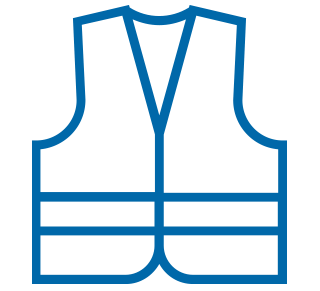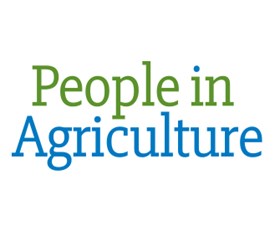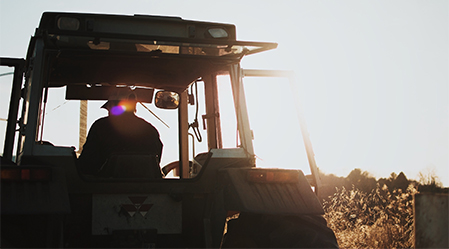Safety in the Workplace

Employer and Worker Responsibilities
We all deserve a safe place to live and work. Preventing injuries in the workplace should be a priority for everyone on the farm. It is not just an employer’s responsibility to make sure all workers are safe. You also have a responsibility to perform your job in the safest possible way and to avoid creating any risks or hazards for others on the farm.
It is the employer’s responsibility to ensure that all equipment and machinery is checked properly and has the appropriate guards and safety measures in place. However, it is your responsibility as a worker to let your employer know if any equipment becomes ‘unsafe’.
You are also legally required to speak up if you feel you are being asked to do something that you are either not qualified to do or that produces unnecessary risks for your or other people on the farm.
Your employer should cover health and safety policies and procedures on the farm, including where these policies and procedures are kept, during the Induction process. Your employer will most likely give you a safety induction checklist that has information relevant to your workplace. The sample safety induction checklist is an example only and does not take into account an individual’s circumstances or different types of employment.
Reporting Accidents and Potential Hazards
All work-related injuries, accidents, incidents and even some near misses need to be reported so they can be investigated as soon as possible. Once an investigation takes place, your employer can put controls in place to prevent these incidents recurring.
Often you are ‘on the front line’ in the farm and your employer may rely on you to let them know what is happening in the workplace on a daily basis. Put simply, if your employer doesn’t know there is an issue or potential hazard, how can they be expected to fix it?
When an injury (minor or major) has occurred, the injured person must:
- report the injury or work-related illness to their supervisor or employer as soon as possible, some accidents should also be immediately reported to Workers’ compensation Authority (“Authority”) (see the Safe Work Australia Incident Notification Information Sheet)
- enter the details in the farm’s Injury & Incident Register or have another person complete the register
- obtain a WorkCover medical certificate from the treating doctor, where the injury requires treatment, and give the certificate to the employer
Near misses should also be recorded - see the sample hazard / near miss report document for an example of how these might be recorded If you don’t know where to find these documents in your workplace, ask your employer where they are located. There should also be a copy of the WorkSafe Victoria “If you are injured” poster somewhere in your workplace.
Sample Injury and Incident Register – Word Doc
Hazard / Near Miss Report Sample – Word Doc
Policies and Procedures
Policies, procedures and systems provide an invisible ‘structure’ to the business that helps everyone understand how and why things should be done. Well thought out and well planned procedures can help to make sure that everyone on the farm knows the safest and most productive way to complete their job.
If you feel that a workplace procedure needs updating or amending, you should discuss this with your employer. Employers often rely on and expect feedback from people who are implementing the procedures every day. Voicing your concerns or sharing ideas may result in a safer and more productive workplace for everyone.
Workplace policies generally outline acceptable behaviours, set out consequences for not following policies, and often reinforce and clarify standard operating procedures. You will probably be introduced to the workplace policies as part of the Induction process. During this process you might also receive a Code of Conduct This is a document that provides a summary of the most important policies and should be discussed and signed at induction.
Safe Work Australia
Safe Work Safe Australia is a national regulatory body that develops and improves polices relating to safety in the workplace. They also have information about workers compensation and links to governing bodies in states and territories. It is a good idea to contact your state or territory body first if you are looking for more information regarding workplace safety.
Workers compensation is a type of insurance for accidents that occur in the workplace and it can provide financial assistance for medical bills, wage replacement, and rehabilitation if needed. The state workers compensation bodies also provide advice to employers and employees about the best way to reinstate someone into the workplace. See the state or territory specific sites below for more information.
It is always better to prevent an injury or accident rather than try to compensate for it. Here are some of Safe Work’s top tips for safety on the farm.
- Application of parking brakes prevents run overs, even on relatively flat ground
- Working alone increases risks if something goes wrong. Let someone know where you’ll be and when you’re due back. Take a mobile or two-way, making sure it is fully charged before you leave and check in. Have an in-house arrangement with the owner or manager of maintaining reasonable contact
- Use equipment best suited for the job
- Ensure you are properly trained and qualified for the job you are doing
- Relying on someone’s (or your own) skill and experience can lead to over-confidence and risk-taking
- Having fall protection and using it prevents deaths, brain damage and permanent spinal injuries
- Wear a helmet when riding a quad bike, motorbike or horse and any other Personal Protective Clothing, Aids or Equipment required for that particular job
- Observe proper Manual Handling Procedures and other Codes of Practice
- Working areas of farms and farm machinery are no place for children
- Know your limitations
State and territory specific information regarding current work safety information and laws can be found at the following sites:
Victoria www.worksafe.vic.gov.au
Tasmanian www.worksafe.tas.gov.au
New South Wales www.workcover.nsw.gov.au
Western Australia www.docep.wa.gov.au/WorkSafe
Queensland www.worksafe.qld.gov.au
South Australia www.safework.sa.gov.au
Northern Territory www.worksafe.nt.gov.au
Federal www.comcare.gov.au





